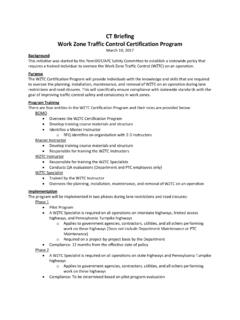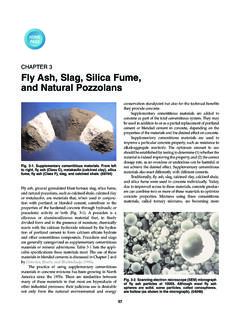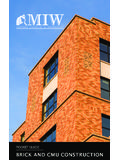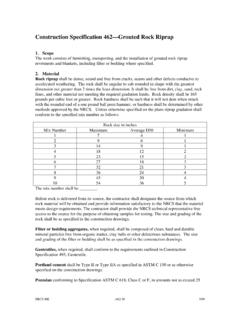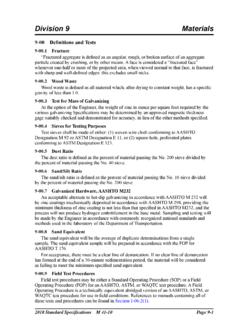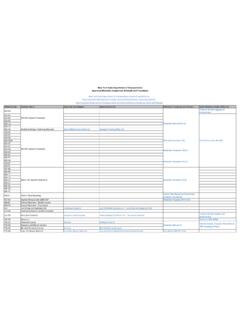Transcription of SECTION 704—CEMENT CONCRETE
1 P-b07042-B. Instructions for Use: These are changes to SECTION 704 and SECTION 1001 for bridge deck performance. For use on projects as listed for each district on the spreadsheet entitled Improved Bridge Deck Performance Pilot Projects 2016 located at P:\penndot shared\Improved Bridge Deck Performance Committee District Surveys\Improved Bridge Deck Performance Pilots. Also include PTM 528 located in the ECMS File Cabinet as an attachment to the proposal. HEADER: b07041 SECTION 704 and SECTION 1001. Provision Body: SECTION 704 CEMENT CONCRETE . SECTION (b) Material. Revise to read as follows: (b) Material. Cement, Type I/II SECTION 701. Fine Aggregate, Type A SECTION Coarse Aggregate, Type A, Maximum size AASHTO No. 57, unless approved by the District Materials Engineer/District Materials Manager (Stone, Gravel, or Slag) SECTION Water SECTION Admixtures SECTION Pozzolan SECTION 724. Table A Cement CONCRETE Criteria. Revise to read as follows: Page 1 of 12. P-b07042-B. TABLE A. Cement CONCRETE Criteria Minimum Maxim Mix(2,9) Design Proportions 28-Day (3)(5) um Coarse(1) Structural Cement Factor Compressive Class of Water Strength Aggregate Design Use (lbs/cu.)
2 Yd.). CONCRETE Cement (psi) Solid Compressive Ratio(6) Volume Strength Days (lbs/lbs) (cu. yd.) (psi). Min. Max. 3 7 28. AAAP Bridge Deck 560 640 3,000 4,000 4,000. HPC Bridge Deck 560 640 3,000 4,000 4,000. AAA(4) Other 752 3,600 4,500 4,000. Slip Form AA 752 3,000 3,750 3,500. Paving(7). AA Paving 752 3,000 3,750 3,500. Accelerated AA 800 3,750 3,500. Patching(8). AA 752 3,000 3,750 3,500. Structures A 564 752 2,750 3,300 3,000. and C 658 1,500 2,000 2,000. Misc. HES 752 846 3,000 3,750 3,500. Notes 1 and 3 pertain to structure and miscellaneous CONCRETE only. (1) Proportions shown in the table are shown on the reverse side of Form TR 4221-B and are controlled by class of CONCRETE , fineness modulus of fine aggregate (PTM No. 501) and the solids percent in coarse aggregate (PTM No. 617). (2) Test Procedures: Slump AASHTO T 119; Compressive Strength PTM No. 604, or Maturity Meter Method PTM No. 640. The upper age limit and lower age limit are defined by the values listed for 7-day and 28-day compressive strength.
3 (3) For use in miscellaneous or structural CONCRETE , if the Fineness Modulus (FM) is between and , increase the minimum cement factor for the class of CONCRETE 47 lbs/cu. yd. This requirement may be waived after adequate strength data is available and analyzed according to the mix-design SECTION in ACI 211. (4) AAA CONCRETE is not permitted to be used for new bridge decks. (5) For exception, see SECTION (c). Cement factor may be increased to a maximum of 690 with the approval of the DME/DMM. (6) If a portion of the cement is replaced by pozzolan, use a water to cement plus pozzolan ratio by weight. The minimum water cement ratio for AAAP is ( ). (7) For slip form paving, provide coarse aggregate or a blend of coarse aggregate that has a minimum of 35%. passing the 1/2-inch sieve. Base these results on the average of three samples, with no single sample result below 30% passing. Conduct testing at the CONCRETE plant according to the QC Plan. Segregated stockpiles may be reworked and retested if material fails to conform to this requirement.
4 (8) For accelerated cement CONCRETE , submit mix design, as specified, SECTION (c), having a minimum target value compressive strength of 1,500 pounds per square inch at 7 hours when tested according to PTM. No. 604. (9) AAAP trial mixtures are required to produce a minimum 28-day compressive strength of 4,500 pounds per square inch (500 pounds per square inch overdesign). Page 2 of 12. P-b07042-B. SECTION (c) Design Basis. Revise to read as follows: (c) Design Basis. 1. General. Compute and prepare CONCRETE mix designs according to ACI 211. For AAAP mix designs, determine the aggregate gradation for the mix design according to PTM 528. Base CONCRETE mix designs on the materials to be used in the work. Make trial mixtures for each class of CONCRETE and mold and cure test specimens. If the requirements of Table A. cannot be achieved, furnish other acceptable materials or make necessary changes in the mixing procedure to conform to the specified requirements. Notify the District Materials Engineer/District Materials Manager (DME/DMM) at least 3 days in advance of preparing trial mixtures.
5 At the start of construction, mix a full-sized batch using the type of mixer and the mixing procedure planned for the project. Use this batch to provide the basis for final adjustment of the accepted design. 2. Cement Factor. For all classes of CONCRETE , use the minimum cement factor (cement or cement and pozzolan combined) specified in Table A, except as follows: If flyash is used, the Portland cement portion may be reduced by a maximum of 15%. If ground granulated blast furnace slag is used, the Portland cement portion may be reduced by a minimum of 25% to a maximum of 50%. If Mechanically Modified Pozzolan-Cement combinations are used, the Portland cement portion may be reduced by a maximum of 50%. For AAAP cement CONCRETE , replace Type I/II Portland cement with pozzolan (silica fume or flyash or ground granulated blast furnace slag) weighing as much as or more than the Portland cement replaced. The percentages of pozzolan applicable to AAAP CONCRETE are as shown below. Limit pozzolan to not more than two of the three pozzolans listed below in any one mix design as long as one of the pozzolan supplements meets the minimum percentage of replacement.
6 Cement factor must include at least one of the following as a replacement for a portion of the cement: Ground Granulated Blast Furnace Slag 25% (min). (GGBFS) (Grade 100 or higher). Fly Ash (Type C or Type F) 15% (min). (Minimum cement content = 510 lb/cy). Silica Fume 5%-10%. 3. Air Content. Design cement CONCRETE to have an air content of in the plastic state. Design AAAP. CONCRETE mixes to have an air content of in the plastic state. Obtain the air content through the addition of a solution of an air-entraining admixture as specified in SECTION (e)4. Use the quantity of air-entraining admixture necessary to maintain the plastic CONCRETE air content, determined according to AASHTO T 152 (DO NOT APPLY. AN AGGREGATE CORRECTION FACTOR) for stone and gravel and AASHTO T 196 for slag coarse aggregate, within a tolerance of during the work. The plastic CONCRETE air content includes entrapped and entrained air. If the hardened CONCRETE exhibits deficiencies or the Representative suspects the hardened CONCRETE to have deficiencies, and, if directed, determine the percent of entrained air in the hardened CONCRETE according to PTM No.
7 623. Voids greater than mils and less than 40 mils in their smallest dimension are considered entrained air. Voids 40 mils or more in diameter are considered entrapped air. The entrained air in the hardened CONCRETE must be between and , inclusive. For AAAP mixes, the entrained air in the hardened CONCRETE must be between and inclusive. 4. Mix Design Acceptance. Submit a copy of each completed mix design to the Representative before its use in the work. The Department reserves the right to review any design through plant production before its use in Department work at no additional cost to the Department. The CONCRETE design submitted for review is required to comply with the specified CONCRETE class requirements, supported by slump, air content, and compressive strength test data according to ACI 211. The Department will accept CONCRETE designs on the basis of the 7-day strength tests (Class High Early Strength (HES) may be accepted on the basis of 3-day strength tests); however, conduct 28-day tests to show the potential of Page 3 of 12.
8 P-b07042-B. the design mix. The Department may also accept designs based on the 28-day tests. Design AAAP cement CONCRETE mixtures to achieve slow strength gain. Adjust component proportions with an objective of attaining a 28 day to 7 day compressive strength ratio during design greater than or equal to A. PennDOT inspector will witness the compressive strength tests. A waiver by the DME/ DMM for SECTION Table A for cement factor and/or water cement ratio may be allowed if mix designs using the limits of the Table cannot achieve the ratio. The ratio is for mix design purposes only and not to be utilized as an acceptance factor during production. In no case will the Department accept any mixture during design which fails to meet a minimum 28 day to 7 day compressive strength ratio less than Additional criteria for mix design acceptance of AAAP CONCRETE are as follows: The producer is required to complete the following tests before mix design submittal and approval. Maximum Permeability - Design the CONCRETE mixture to meet a target maximum permeability of 2000.
9 Coulombs after a 56 day curing period in accordance with AASHTO T 277. Shrinkage (Microstrain) - The 28-day shrinkage based on ASTM C 157 is not to exceed 500. microstrain. Wet cure specimens in the lab for 14 days before beginning the 28-day shrinkage testing (42 total days). A higher class CONCRETE may be used in place of an indicated lower class CONCRETE if the higher class CONCRETE conforms to all of the requirements of the indicated lower class, and if approved by the Department. SECTION (d) QC Sampling and Testing of Plastic CONCRETE . Revise to read as follows: 4. QC Testing. Perform QC testing according to the reviewed QC Plan and as follows: QC Sampling and Testing of Plastic CONCRETE . Select an appropriate slump value that will provide a workable mix for the construction element. The Contractor's technician must have a copy of the Department reviewed QC Plan in their possession during testing and must be aware of the target slump for the structural element being placed. Do not exceed the following slump upper limits: Type of Mix Slump Upper Limit without water reducing admixtures 5 inches with water reducing admixtures 6 1/2 inches with high range water reducing admixtures (superplasticizers) 8 inches mixes specified in SECTION (h) 2 1/2 inches (except tremie CONCRETE as specified in SECTION (j)).
10 AAAP 5 inches Perform plastic CONCRETE slump, air, and temperature tests on the first three consecutive trucks at the beginning of CONCRETE placement operations or after a significant stoppage such as plant or equipment breakdown to determine if material control has been established. Material control is established when all test results of CONCRETE slump, air, and temperature for three consecutive trucks are determined to be within the established action points. Obtain samples of fresh CONCRETE according to PTM No. 601. Perform slump tests according to AASHTO T 119, air content tests according to AASHTO T 152 (DO NOT APPLY AN AGGREGATE CORRECTION FACTOR) or T 196 and temperature tests according to ASTM C 1064. Report test data to the CONCRETE technician promptly in order to facilitate necessary changes. Continue testing consecutive trucks until material control is established. Once material control is established, the frequency of testing may be reduced to a minimum of one test per 50 cubic yards.
